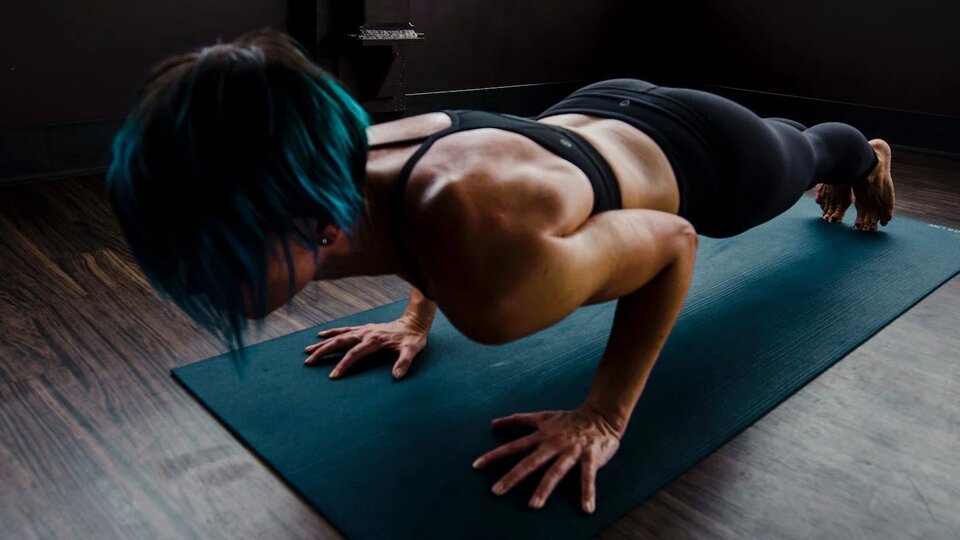The body is an athlete’s tool. A self-reliant athlete can make themselves stronger through their own bodyweight in calisthenics. For anterior hypertrophy, push-ups can be as beneficial as the bench press. It’s been proven that they can produce the same levels of muscle thickness and strength progression (1). However, just the plain push-up can get stale over time, so it’s time to update your push-up game.
Resistance Band Push-Ups
Gains are made with the proper mind-muscle connections. Resistance bands can help with muscle recruitment. Resistance Band Push-Ups will provide a well-rounded exercise for the chest, shoulders, and triceps.
Some may prefer to put a weight plate or a backpack on for more resistance. However, these options can limit focus and range of motion. The focus of keeping the weight balanced would take away from the focus on ROM. Luckily, resistance bands remain in place. It can wrap over or under the arms depending on the desired target muscles.
The data has shown that resistance bands assist in recruiting additional muscles through electromyography, a measure of muscle activation. A weighted push-up may cause more stress, but the resistance band applies more mind-muscle connection (2).
30-Second Push-Up
Every movement requires tempo, or the control of time under tension (TUT). This proves an understanding of the body no matter the resistance. The 30-Second Push-Up applies TUT for a unique choice of resistance.
The slow tempo of the body will slow down the mind, allowing it to notice certain cues that would be missed in a fast-paced rep which can also improve technique. The concentric and eccentric phases can vary in time depending on the focus. Either way, the slowness will build up tension in the exercise. This can be a great compliment to the Resistance Band Push-Up.
Incline/Decline Push-Ups
The chest is made up of three heads. Push-ups can hit these heads by changing the horizontal angle of the exercise. A standard push-up can target the sternal (middle) head, but what about the other two?
Incline Push-Ups target the lowest head, the abdominal head. This version elevates the upper body while keeping the feet at ground-level. The higher the elevation, the more the abdominal head and triceps will contract in the push-up. It can even allow for a deeper eccentric phase by bringing the chest below the hands. This can be achieved by placing the hands on a stack of books or using parallel bars. It’s a good progression towards Parallel Bar Dips.
Decline Push-Ups target the clavicular head. This head of the chest connects the rotator cuff and the deltoid. Unlike the Incline Push-Up, the feet are elevated instead. The higher the feet, the more the shoulders will work against gravity. This is a great progression for Handstand strength. Soon, the feet could get high enough for Wall-Supported Handstands.
Archer Push-Ups
Push-ups are a vertical movement, while Archer Push-Ups are the horizontal version. This follows and lengthens the muscle fibers going across the pectoralis minor, similar to the chest fly. Exercises like the Archer Push-Up can improve mobility in the pectoralis minor, leading to a healthy scapular posture (3).
To start, the hands should be wider than shoulder width and facing away from each other. During the eccentric phase, the body will resemble an archer drawing an arrow from their bow. Despite being a unilateral movement, the side not in focus is still assisting the other. The side holding the arrow is stabilizing weight distribution and preventing a pec tear on the side with the bow. The “arrow” aims to spot the “bow” to a safer ROM.
Pseudo Planche Push-Ups
The Pseudo-Planche Push-Up may be the hardest of this bunch. This will challenge weight distribution across the entire body through shoulder mobility and core strength. In yoga, it’s known as the Chaturanga Push-Up. It also puts a great deal of force on the wrists, so a wrist warm-up is highly recommended.
Unlike a traditional push-up, the body is hollowed out by pulling apart the shoulder blades and tucking the tailbone. The body leans forward to even out its weight on top of the hands. In the eccentric phase, the elbows travel towards the ribcage like a close-grip bench press. The concentric phase returns the shoulder blades into a hollow shape. In time, the core and glutes can get strong enough to lift the toes off the ground during a repetition or planche hold.
Conclusion
It is possible to exercise the various parts of the chest through push-ups alone by changing the angles and directions of the movement. These exercises can be combined through supersets for a great upper-body day. Don’t let a lack of weights hold you back from making some serious gains.
Works Cited:

740825 585976Wow, superb weblog structure! How long have you been blogging for? you make blogging glance straightforward. The total appear of your web internet site is exceptional, neatly as the content material! 20051